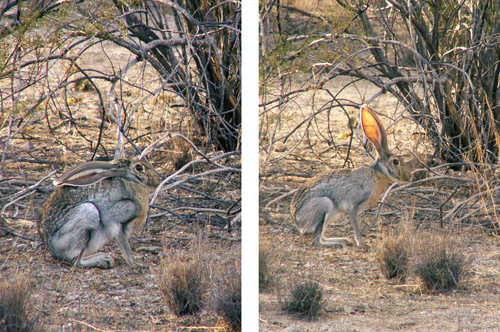|
Art of Science 2010 Online Gallery
«Prev |
Thumbnails |
Next »
|
 Hare-ball
Henry S. Horn (fac)
Dept. of Ecology and Evolutionary Biology
I study energetic interactions between organisms and their environment, particularly the geometry of leaf arrangement for capturing light in trees and forests, ... but I am also interested in the ways that animals arrange their bodies and their physiology to cope with extreme environments. Here is a Desert Hare near sunset on a cold (4°C) winter evening in Saguaro National Park East, near Tucson, Arizona (10.March.06). The Hare is doing the best it can to become a sphere, to minimize its surface-to-volume ratio, and so to minimize its loss of energy. This is quite a trick since the Hare is otherwise designed to radiate excess summer heat through its lanky limbs and ears. The left photo shows the Hare as discovered. The right photo shows a more typical pose, as the sun broke through a gap in the clouds, and the Hare prepared to leave. Note the prominent energy-exchanging blood vessels exposed in its ears.
|
|